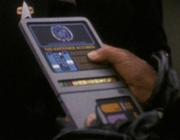KTF/KhitomerAccords
| Line 21: | Line 21: | ||
The Second Khitomer Accords were signed in 2368, between the Klingon Empire and the Federation. But, by this time, other Alpha Quadrant powers also participated in this Treaty. It has been argued that this Treaty is the least influential of any treaty, to date, with many of the provisions in whole, or in part, ignored by many of the powers. <br><br> | The Second Khitomer Accords were signed in 2368, between the Klingon Empire and the Federation. But, by this time, other Alpha Quadrant powers also participated in this Treaty. It has been argued that this Treaty is the least influential of any treaty, to date, with many of the provisions in whole, or in part, ignored by many of the powers. <br><br> | ||
The major points of the Treaty were: <br><br> | The major points of the Treaty were: <br><br> | ||
| − | + | [[Image:klingonsm.gif]]Subspace weapons were banned, but provisions were made for low-yield subspace munitions such as the Federation’s Tri-cobalt device, provided that their usage was not widespread. <br><br> | |
| − | + | [[Image:klingonsm.gif]] The use of biogenic and other “Weapons of Mass Destruction” were also prohibited. <br><br> | |
The Organian Peace Treaty was a peace treaty forced upon the United Federation of Planets and the Klingon Empire by the Organians in 2267 shortly after the outbreak of war between the two interstellar powers, which had resulted in the Klingon occupation of Organia. The treaty was agreed to under the threat of the Organians immobilizing both side's space forces if they did not cooperate - a power the Organians had already exhibited by disabling forces from both sides above, and on, Organia. In addition to an end to direct hostile acts, terms of the treaty included shared occupation rights. The Klingon High Council felt compelled to agree to the treaty under the Organians coercion, but were not pleased with the state of affairs and immediately began to formulate tactics to circumvent it; these included espionage, and the manipulation of the Romulan Star Empire into an alliance, in which they hoped to use to the Romulans to wage war against the Federation. Makrecha IV was one of the disputed worlds under the Treaty of Organia. A Klingon settlement existed there by 2285 and a Federation colony was established in that year. <br><br> | The Organian Peace Treaty was a peace treaty forced upon the United Federation of Planets and the Klingon Empire by the Organians in 2267 shortly after the outbreak of war between the two interstellar powers, which had resulted in the Klingon occupation of Organia. The treaty was agreed to under the threat of the Organians immobilizing both side's space forces if they did not cooperate - a power the Organians had already exhibited by disabling forces from both sides above, and on, Organia. In addition to an end to direct hostile acts, terms of the treaty included shared occupation rights. The Klingon High Council felt compelled to agree to the treaty under the Organians coercion, but were not pleased with the state of affairs and immediately began to formulate tactics to circumvent it; these included espionage, and the manipulation of the Romulan Star Empire into an alliance, in which they hoped to use to the Romulans to wage war against the Federation. Makrecha IV was one of the disputed worlds under the Treaty of Organia. A Klingon settlement existed there by 2285 and a Federation colony was established in that year. <br><br> | ||
When the Klingons began staging attacks inside a wormhole near the Neutral Zone in 2285, Admiral James T. Kirk wondered how the Organians could allow it under the terms of the treaty. Kirk investigated further, and discovered that the Organians were unable to enforce the treaty due to manipulation from the race known as the Excalbians. Once freed from Excalbian control, the Organians engaged the Excalbians in a battle that resulted in the two races leaving the material plane and the dissolution of the treaty. <br><br> | When the Klingons began staging attacks inside a wormhole near the Neutral Zone in 2285, Admiral James T. Kirk wondered how the Organians could allow it under the terms of the treaty. Kirk investigated further, and discovered that the Organians were unable to enforce the treaty due to manipulation from the race known as the Excalbians. Once freed from Excalbian control, the Organians engaged the Excalbians in a battle that resulted in the two races leaving the material plane and the dissolution of the treaty. <br><br> | ||
Revision as of 17:05, 26 July 2013
Klingon Task Force Main Page

| ||||||
THE KHITOMER ACCORDSby Frances B. Brock
|
In 2372, after Gowron had become Chancellor, he withdrew the Empire from the Khitomer Accords in response to the Federation Council’s condemning of Gowron’s ordering the invasion of Cardassia Prime. The following year, Gowron decided to reinstate the Treaty, when a newly-formed alliance between the Dominion and the Cardassian Union threatened to throw the Alpha Quadrant into war. The Second Khitomer Accords: Section 1 Section 2 Section 3 Section 4 Section 5 Sources
|
|||||

